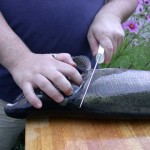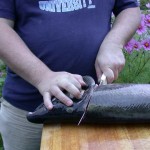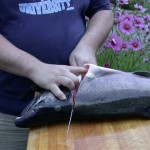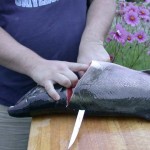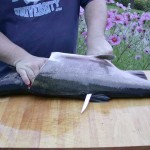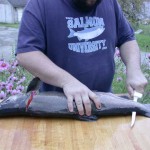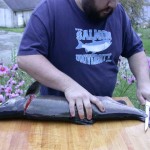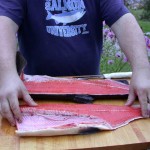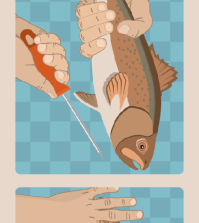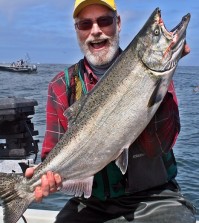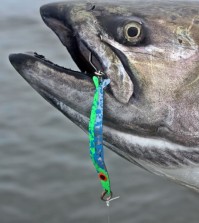How to Fillet a Salmon
OK, once you’ve got your knife sharpened and your workspace established, it’s time to move on to the filleting. We’re assuming that you’ve already gilled and gutted your fish… if you don’t know how to do this, have no fear, we’ll be adding a “how-to” section on gilling an gutting here soon.
The first step in filleting is to make sure you’re comfortable with where the fish is placed. It’s really all a matter of personal preference. I prefer to start my filleting with the fish laying in front of me as it’s pictured below, with its head to my right, and its belly facing me. But then again, I’m one of those strange left handed people, so what feels right for me may feel wrong for you… make sure you do what feels comfortable to you.
1. Make the first cut just behind the gillplate, in the first soft section of tissue. Make this cut straight down, perpendicular to the backbone, or just a little slanted, as shown below.
2. Cut all the way down to the backbone, but don’t cut through the backbone
3. Once you’ve cut down to the backbone, make sure you cut and free the lower (belly) section also.
4. While holding the knife against the backbone, turn it 90° so the cutting edge faces the tail and the blade is parallel to the backbone. Then, while holding the belly flap up with one hand, start cutting towards the tail, with the blade parallel to the backbone, or angled just slightly towards the backbone, so it rides against it. You want to use the backbone as your guide. In the other axis, the tip of your blade should be angled a little towards the cutting board, as shown… you do this so your cut comes closer to the dorsal fin, you don’t want to leave a thick strip of meat on the carcass above the backbone… you want that meat to end up on your fillet!
5. At first, you’ll be cutting through the rib bones, so the first part might take a little effort… this is why you want a nice sharp knife! Continue to hold the belly meat up so it doesn’t get accidently cut by the blade, and work the blade along the backbone, back towards the tail. Notice how close the blade is to the dorsal fin… you want to pass just above it, leaving the most meat possible on your fillet.
6. Again, you want the blade to pass just along the anal fin, and right along the backbone also, leaving as much meat as possible on your fillet. Notice the angle of the blade, angled slightly towards the backbone… you want to use the backbone as a guide… you don’t want to go too deep and dig into the backbone, and you don’t want to go too shallow and leave some meat on the backbone… it’s a delicate balance, one that takes practice.
7. At the tail of the fish, run your blade out along the backbone, and then angle slightly upward, through the skin.
8. There it is, the first fillet, off the bone. We will rib and clean up this fillet after we cut the next fillet.
Latest News
-
Fishing Reports – October 23, 2024
Washington Marine Area 1 (Ilwaco) No report this week. Marine...
- Posted October 24, 2024
- 0
-
Fishing Reports – October 16, 2024
Washington Marine Area 1 (Ilwaco) No report this week. Marine...
- Posted October 16, 2024
- 0
-
Fishing Reports – October 9, 2024
Washington Marine Area 1 (Ilwaco) No report this week. Marine...
- Posted October 10, 2024
- 0
-
Fishing Reports – October 2, 2024
Washington Marine Area 1 (Ilwaco) No report this week. Marine...
- Posted October 2, 2024
- 0
-
Fishing Reports – September 25, 2024
Washington Marine Area 1 (Ilwaco) No report this week. The...
- Posted September 25, 2024
- 0
-
Fishing Reports – September 18, 2024
Washington Marine Area 1 (Ilwaco) No report this week. The...
- Posted September 18, 2024
- 0
-
Fishing Reports – September 11, 2024
Washington Marine Area 1 (Ilwaco) No report this week. The...
- Posted September 11, 2024
- 0


